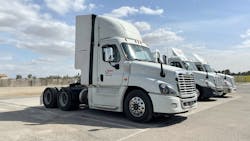TruckLabs hits half-billion-mile mark with aerodynamic device
As fleets attempt to save on fuel costs, comply with federal greenhouse gas emissions standards, and meet growing sustainability goals, they seek additional ways to reduce aerodynamic drag and carbon emissions on the vehicles available to them today.
One technology supplier in the space, TruckLabs, has reached a half-billion miles driven with its TruckWings device, resulting in about 32,648 metric tons of CO2 saved to date. TruckWings is a fully automated aerodynamic device built for trucking fleets and is deployed on five of the largest fleets in North America—including Ryder, which ranks No. 3 on the FleetOwner 500: Top For-Hire Fleets of 2022 list.
TruckWings is tractor-mounted and designed to close the gap between the tractor and trailer of Class 8 trucks resulting in fuel savings of 3% to 6%. The device also extends the range for electric trucks by 5.5%, TruckLabs said in a press release.
See also: Finding the efficiency sweet spot in trucking
“Five hundred million miles is a huge milestone for us. It demonstrates our sustained commitment to delivering durable, double-win results on both carbon emissions and dollars. Our telematics technology tracks every mile driven through harsh Canadian winters and asphalt-melting Arizona summers. It’s a huge credit to the team’s engineering work to hit this milestone so quickly,” TruckLabs founder and CEO Daniel Burrows said. “TruckWings help fleets reduce fuel costs and emissions today and will improve the range of electric trucks in the future.”
During an interview with FleetOwner, Burrows added that a lot of fleets running compressed natural gas trucks equip their vehicles with TruckWings because of those range-extension and power-enhancement capabilities. He noted that aerodynamics becomes even more critical as the industry adopts more alt-fuel technologies.
Burrows also was quick to point out that his company’s 500-million-mile milestone isn’t based on estimates; rather, it’s real-world telematics data coming off the devices.
“Each one phones home and tells us what’s going on,” he explained. “For those half-billion miles, we can tell you which trucks, which routes, which customers, and the performance of those units.”
TruckWings are becoming more widely deployed across the trucking industry and each unit on the road helps save about 20,000 lb. of carbon emissions annually, the company noted. TruckLabs is working with several manufacturers to become a standard spec on their trucks, so fleets won’t have to rely on aftermarket upfits, Burrows told FleetOwner.
See also: Fleets try to meet shippers’ newest request: sustainability
“At highway speeds, two-thirds of fuel is spent overcoming aerodynamic drag. In today’s environment, designing a more streamlined truck is the most cost-effective way to improve a truck’s efficiency," TruckLabs VP of product Andrew Kelly said. “Truck manufacturers understand that improved aerodynamics are the most efficient way to meet stringent new regulatory standards. They are looking to us to help them get there. This is especially true in the day cab market where tractor aerodynamics have lagged against their sleeper counterparts.”
Today, many of the fleets TruckLabs works with are buying TruckWings because of sustainability initiatives to meet their strong internal targets for their carbon levels, as well as their customers’ climate targets.
“Companies within the industry are answering with what their customers are asking for,” Burrows explained. “Their customers are asking for electric. That’s not possible today, in many ways, but it’s growing. So, what we’re saying is give them a more efficient truck as a steppingstone towards electric. Invest in the vehicle platform because eventually you will swap out that [internal combustion engine] with an electric motor. People are asking for it, and ultimately, it’s the consumer asking for it.”
About the Author

Cristina Commendatore
Cristina Commendatore is a past FleetOwner editor-in-chief. She wrote for the publication from 2015 to 2023.
